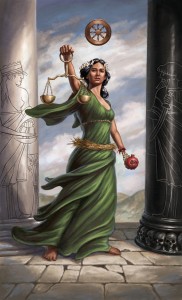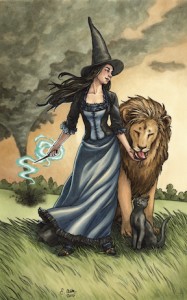Interview with Scott Murphy and Elisabeth Alba
Today we have a very unique opportunity to hear from two artists who recently completed two different decks. The artists also happen to be married. Elisabeth and Scott graciously took the time to answer some questions for us.
Modern Spellcaster’s Tarot by Melani Marquis and Scott Murphy, Fall 2016 (available for pre-order HERE)
Everyday Witch Tarot by Deborah Blake and Elisabeth Alba, Winter 2017
1. What was your favorite part of working on this project?
Elisabeth: Seeing it all come together is truly amazing! The process is fun, especially the painting (I love coloring), but I always get a thrill when I see the finished product of whatever I’m working on, the result of all that hard work! I can’t wait to see it printed and I’m excited to see how the package design looks.
Scott: I really enjoyed getting to explore deeper into the symbolism of the cards. I didn’t know all that much about tarot before starting this project, so it was an interesting learning experience for me. Creating such a large body of work and seeing it come together into a full deck is also a very gratifying experience. It’s difficult to envision how the deck will look at the beginning of the project, but slowly you start to see the result emerging as a whole and it makes all of the hard work pay off.
2. What was the most challenging?
Elisabeth: The amount of work is daunting. A year and a half sounds like a long time… but for 79 paintings, it isn’t! Scott had started his deck months before I started mine, so I had an inkling of how much work it would be and it definitely made me nervous. Also sometimes it gets tough to work on the same project so intensely for so long. Sometimes I wished I had more time to refresh my brain by working on something else… yet there was no time to take on many other projects. I wanted to make each image a solid composition, and make sure that they didn’t all look the same. I didn’t want to fall behind, feel more overwhelmed, and rush through any of them.
Scott: I think for me a big challenge was trying to stay motivated and focused while balancing the many other aspects of life. When I started my deck I was in the midst of grad school, so I had to do a lot of juggling many different paintings at a time. Elisabeth and I were also in the process of planning our wedding, and even though she was doing a lot of the important stuff, it was still something I was giving a lot of attention to in addition to other commissions. Working so long and intensely on a project of this size was quite tricky and at times discouraging, but it proved to be a good exercise for me to push through and stay on task until the end. After painting three to four illustrations a week for such an extended period of time, now I feel like I can take on almost any project.
3. What surprised you the most?
Elisabeth: How much I continued to enjoy working on it, even with my occasional bouts of wanting to do something different. I’ve gotten sick of working on long-term projects before, to the point of hating them, but even while painting the 79th image, I was still having fun, and still pleased with my work.
Scott: I’m surprised by the warm enthusiasm of the tarot community. Ever since I started this project I have seen and received many nice comments from fans excited about the art and looking forward to the deck. There has been more positive reaction to the works I’ve done for the deck by tarot fans, than many of my illustrations created for non-related projects, and it’s really great to know that people enjoy what I’ve worked so hard to create. I hope once the deck is released that it lives up to their expectations!
4. What did you know or think about tarot before taking this project on and how did it change after the project?
Elisabeth: Admittedly, I didn’t know much. I’d had tarot readings before, and I always appreciated the art on decks I had seen, but once Scott and I started working on our decks, I could really see how huge the community was and how different decks could be, even ones based on Rider-Waite-Smith. I had no idea how many decks were in existence, or how many continue to be made, and not just through Llewellyn. It’s a whole new world!
Scott: I was fairly unknowing about tarot when I was approached to create my deck. I had been familiar with the various cards through seeing projects that other artists had worked on, but not much beyond that. But through working on the deck, I ended up doing a lot of research on the different cards and their meanings, as well as purchasing a couple decks for myself. So while I still don’t know a ton about every single card, I appreciate the decks a lot more than I used to.
5. Did you talk to each other about the cards, their meanings, the direction you were given by your authors, about the similarities and differences?
Elisabeth: All the time! We work in the same room together so it was bound to come up each time we got started on new images. It was interesting that our decks were both based on the Rider-Waite-Smith deck, but they have totally imagery, feelings, and atmosphere from each other. Scott’s is a more serious and dark deck. Mine is more lighthearted. Stylistically, Scott’s is more realistic and painterly, done with oil, mine is more brightly colored in a whimsical style, done with watercolor and ink.
Scott: There was a period of time when Elisabeth and I were both working on our decks simultaneously and we barely spoke or thought about anything other than tarot. (Elisabeth comment: And in social settings, the first thing people would ask us was “How’s tarot going?”) Every conversation was about what cards we’re working on next, which thumbnails do you like, how do you think I should show this description, can you pose for this painting, and on and on. We helped each other a lot with feedback on sketches, or modeling for reference photos. I don’t know if I could’ve gotten through the deck without Elisabeth’s help on some aspects of the process, so in some cases I’d say we had a real team effort, even if just for moral support.
6. Would you ever work on another tarot deck again? If so, any particular theme or style you’d be most excited about?
Elisabeth: I think so… but I need a breather and a little time to work on other projects! I don’t want all my previous clients to forget me. But now that I’ve done one, I know what to expect, and it wouldn’t seem as scary from the beginning. As for what I might like to illustrate in the future if I were to do another — I love fantasy and fairy tales! I love looking at and drawing historical clothing, traveling to and reading about historical places, so anything that could combine any of those things would be fantastic to work on.
Scott: While I love the feeling of accomplishment after completing the full deck, I think it would be hard for me to commit that amount of time to just one project again. Especially if it’s not based on a theme that I feel closely connected to. But who knows, maybe some time down the road I’d love to work on something Tolkien themed, or any kind of Viking or Celtic mythology, or dark fantasy, but I’d need more time so I could really paint them big!












What a fun interview! Elisabeth was a joy to work with. (And what they didn’t mention is that they use each other for models, too.)